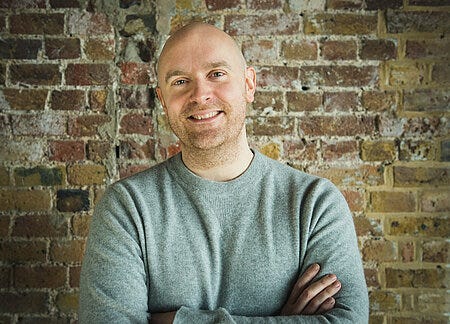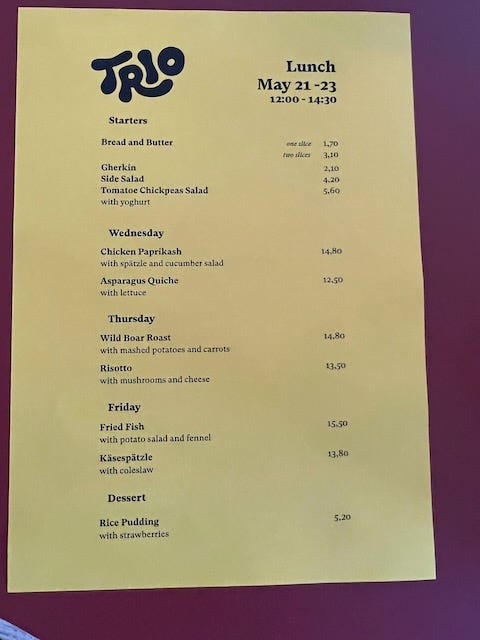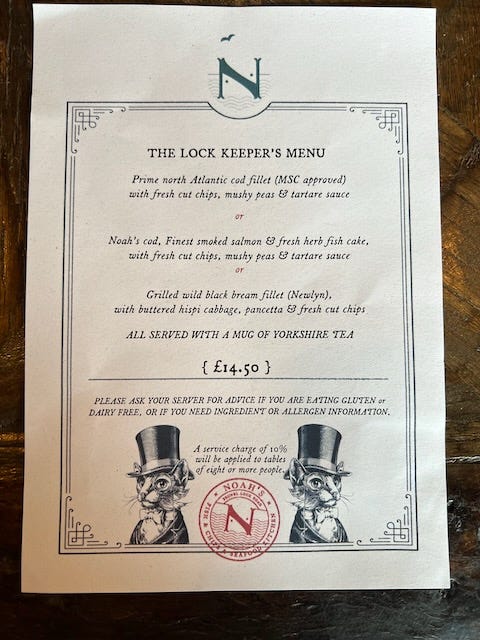This is a free post as I’d like as many of you as possible to join the conversation.
If you’d like to gain access to my recipes, restaurant and travel tips and moneysaving wine tips I’d obviously be hugely grateful. You can sign up here!
I don’t know about you but I’m constantly in a state of shock when I eat out these days.
Mains that I used to regard as expensive at £27 or £28 are suddenly £34 or £35. Or even £42, the price of a special in one of my favourite restaurants the other day. (And that wasn’t for steak.)
Starters are regularly in the teens.
Glasses of wine that were £7 or £8 are £9 or £10
Service which used to be 12.5% is now creeping up to 13.5% or even 15%
A sandwich and half a pint of cider cost me £15 in a very ordinary pub yesterday
There are reasons for this which I’ll go into below but most people’s reaction, if my friends are anything to go by, is simply to eat out less. Or in cheaper restaurants. Which will make those same restaurants less viable.
It’s already happening. This week alone I’ve heard of three restaurants closing, all well known, one Michelin starred. Paco Tapas in Bristol, Chick ‘n’ Sours in London and The Angel in Dartmouth all citing difficult trading conditions
It seemed sensible, since I have a son in the business (Will Beckett of Hawksmoor), to ask him why this is happening. This is his reply.
Restaurants are a pretty simple business (OK, that’s not true, they’re really quite complex and hard, but for the sake of argument …). You rent a building, buy some tables and chairs, install a kitchen, hire some people, cook up a few ingredients, uncork some wine and serve them to a room full of people. Easy!
Except, if you’re a restaurateur, all of that has gone up. Thinking about the time since Covid started, fit-outs have gone up about 30%, labour (or at least National Living Wage) by about 40%, food inflation has been about 40%, and wine prices by just under 30%.
Not only that, but our guests’ costs have increased too, which means that they probably go out a little less, or don’t spend as much when they do.
Oh, and no one goes out late any more. Before Covid a prime reservation slot was 7.30/8pm and a skilled restaurateur could turn tables in an evening. Now the prime slot is 6/6.30pm and very few people want to eat after 8.
Add to that that the tax burden has massively increased, and that there are probably too many restaurants (a remnant from the boom years up to about 2015), and it’s a little bit tricky out there.
What you see is a small number of restaurants doing extremely well (thankfully, Hawksmoor amongst them) and a huge number struggling quite badly.
Restaurateurs can do one of three things to stay afloat: spend less (employ fewer people, lower ingredient costs), be busier (more bums on seats) or put prices up.
Usually, it’s a combination of the three. The first one doesn’t have to be negative by the way. A restaurateur might try to look at selling cheaper cuts of meat to bring prices down for customers, so the restaurant gets busier for example.
The thing is … it’s not a science, it’s an art. No one really knows what will/won’t work, they just tinker and try to find a happy equilibrium.
Unfortunately, lots of independent restaurants are run by people with little time to think big thoughts about how their business should operate, so tinkering (i.e. experimenting, learning from the experiment and adapting) is not an easy option.”
Will at least has big restaurants so can get the bums on seats, as he puts it. But for smaller restaurants it must be more of a struggle.
Dan O’Regan of Bank and the newly opened Lapin in Bristol has just put up a post on his Substack Notes on a Napkin which highlights the challenges, including the sheer unpredictability of food prices.
“We’ve pulled cauliflower cheese from the Sunday roast more than once because the wholesale price doubled in a week. Charging £12 for it felt absurd.
And it’s not just vegetables. Burrata costs more than beef. Storms wipe out seafood supplies or send prices soaring. Turbot is delicious, but not at £50 a portion.”
So where does that leave the punters? The answer for those of us who eat out regularly is to do what we can to support local restaurants though, as Will realistically points out, that’s not what’s in most customers’ minds.
“It’s entirely possible that a very small number of you make your eating out decisions on a benign view of the sustainability of the restaurant industry or your favourite restaurants. But most of you don’t … and that’s fine!
People spend their money in a way that makes sense for them: most of the time, it’s ‘what’s in it for me?’ not ‘what’s in it for the people I’m buying from?’ when you spend money. It certainly is for me, and almost everyone I know.
But assuming you’re one of that very small number who do here’s what you can do.
It may not be practical to eat in the middle of the day but as I’m sure you know set price lunches are always better value. As are early evening deals - or even late evening ones given that people are eating early these days. Jeremy King has reduced the cost of orders by 25% at his Mayfair restaurant, Arlington after 9.45pm. The old post-theatre slot.
Pop in for a dish rather than a 3 course meal as I argue here. You probably only have one course at home. Do you really need three to justify going out?
In a small plates restaurant resist the advice that you need three or four dishes per person. It may well be the way you enjoy eating but the cost always seems to mount up more than you - or maybe I - anticipate.
Enjoy expensive cuts of meat and more expensive wines at home rather than in a restaurant. Dare I say, go veggie when you eat out? Drink beer instead of wine?
Will is much better qualified than I am to suggest what restaurants should do but from observation, I’d suggest for a start, giving people a clear reason to come to you. So you know what you’re going to that restaurant for.
Busy restaurants focus on something that people want. Good steak and cocktails in the case of Hawksmoor. Old school French food including this Camembert soufflé at Joséphine (below). A fantastic vibe (and the perfect pint of Guinness) in the case of The Devonshire.
Look at the successful brands elsewhere in food - the Bold Bean Co which has amazingly made pulses sexy. Or Botivo which has nailed a sophisticated alcohol-free aperitif. Or Mutti tomatoes which are even in Tesco these days. Their messaging is clear and compelling.
Cut down the lunch menu. I went to a brilliant restaurant in Berlin called Trio recently (USP traditional German food). They do a walk-in midweek lunch where they offer a daily changing two dishes (one meat or fish, one veggie) plus a couple of sides. It’s really hard to get a booking in the evening but they make it easy during the day.
Warm, friendly but not over-familiar* service makes people - or at least me - go back. It’s lovely to go to a restaurant where they recognise and welcome you.
*Pet peeve - please don’t continually refer to your customers as ‘guys’
I’m surprised more restaurants don’t do special offers. Not so much at a particular time of day but on specific dishes or drinks - or a combination of the two. My local fish restaurant Noah’s for example offers a free mug of tea with their £14.50 Lock Keeper’s Lunch (an already generous plate of fish and chips).
Or as Will puts it. ‘Write a nice menu/have nice food and customers will come’ is a wishful thinking view of restaurants. Being good at marketing and operationally efficient is at least as important.”
Having said all this the paradox is that many restaurants are still rammed and hard to get into.
It strikes me that there is a generational divide when it comes to eating out - younger customers for whom going out is a way of life (and who are used to being in debt) and the over 50s who are much more price sensitive.
Except maybe for those of you, like me, for whom eating out is one of life’s great pleasures.
Do tell me what you feel about eating out at the moment. And what kind of restaurants appeal to you these days.
And if you found this post worthwhile reading (hopefully yes, if you got this far!) do please give it a like ❤️.
Fi x
PS If I may be so tedious as to mention it again, if you want my supermarket wine recommendations tomorrow why not take advantage of the current third off an annual subscription?!









Such an interesting piece, with great insights from Will. I couldn't agree more about restaurants trying things out/tinkering with their menus to see what works (and what doesn't). There are some (to me obvious) things that put me off going back to a restaurant. For instance, I ate at one West End restaurant recently with a friend who is vegan. I chose the restaurant because it had interesting-sounding plant-based dishes among the meat and fish. On the night I was shocked by the price of the wine, which was so much higher than elsewhere. Every bottle on the menu was upwards of £42, with only an oaky chardonnay slightly less at £38. So many people don't like oaky chardonnays. There was almost nothing by the glass. I asked to taste a Portuguese wine I hadn't heard of that was £42 a bottle but was told I couldn't. I'm not going to spend £42 on a wine that might be horrible. We ended up spending £48 on a wine I knew, but I was so cross about it that I will never go back. I sent a (polite) email with my thoughts, saying that if they had one or two bottles under £40 on the menu, plus more by the glass, they would be likely to entice more people to return. Did I get a reply? Of course I didn't. And NB: the restaurant wasn't even half full, despite it being in a brilliant location with a great atmosphere and an appealing, not overly pricey menu.
Aside from that, we live in a rural area and our two nearest pubs – both owned by the same person and both of which do excellent food that's generally quite pricey – do a community meal on a Monday, all day and evening. One charges £5 (one choice: either meat or veggie), plus it's another £5 if you have pudding; the other charges £15 for two courses (again no choice but always good). Both pubs are generally full and, of course, people drink alongside their £5 mains. I can tell the dishes make clever use of leftovers from Sunday lunches (perhaps a flatbread with seared lamb, a spicy yogurt sauce and lots of fresh herbs/veg; or, one week, pheasant katsu curry); I applaud that. And a community meal gives a strong message: that the pub isn't just for people with deep pockets. Such a great idea.
Dare I say it, it’s relatively simple (not easy, just simple), to operate efficiently. Price appropriately, staff to the right level, spend a little less on your broadband.
There’s almost no substitute for a busy restaurant though. Achieving a critical mass, is without a doubt one of the biggest challenges I’ve faced.
Something I’ve endeavoured to do - counterintuitively - is to bring back some of the opulence of dining out. An abundance of wine by the glass (with a taste prior to ordering, should you want it), complimentary truffles at the end of the meal.
Value is enormously important. That doesn’t mean to be cheap, but rather to exceed expectations. Although there’s a broad spectrum of restaurants and price points, I think for guests to justify a pricier meal out, it’s our job to pepper them with hospitality, and hopefully imbue a sense of warmth on them that makes them endeavour to return.